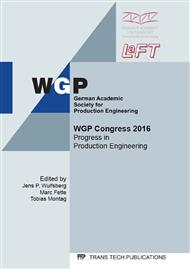p.115
p.123
p.133
p.141
p.149
p.157
p.165
p.173
p.181
Development of a Methodology for Analyzation of the Influence of Pitch Diameter Shift on the Generating Gear Grinding Process
Abstract:
In order to improve load carrying capacity and noise behaviour, case hardened gears are usually hard finished. One possible process for hard finishing of gears is generating gear grinding, which has replaced other grinding processes in batch production of small and middle sized gears due to high process efficiency. Especially generating gear grinding of large module gears with a module higher than mn > 8 mm can be challenging due to high process forces and the resulting excitation, which can influence gear quality negatively. TÜRICH suggested applying a pitch diameter shift during generating gear grinding to equal out the number of contact points between the left and right flanks of the gear with the grinding tool [1]. This qualitative approach is not sufficient to predict the process behaviour because it does not take the changing radii of the curvature of the involute into account and, therefore, the changing contact conditions along the gear profile. In this paper a methodology to quantify the influence of pitch diameter shift on the generating gear grinding process using a manufacturing simulation is introduced. Additionally this methodology is validated for one manufacturing test case.
Info:
Periodical:
Pages:
149-156
Citation:
Online since:
August 2016
Authors:
Keywords:
Price:
Сopyright:
© 2016 Trans Tech Publications Ltd. All Rights Reserved
Share:
Citation:


